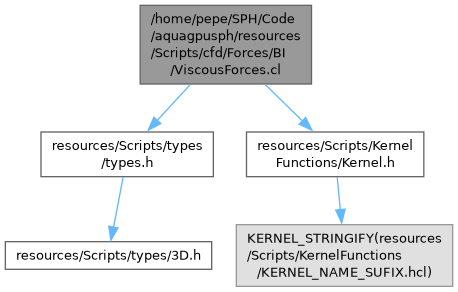Tool to compute the fluid viscous force and moment. More...

Macros | |
| #define | _F_ viscousForces_f[i].XYZ |
Functions | |
| __kernel void | entry (const __global uint *iset, const __global int *imove, __global vec *viscousForces_f, __global vec4 *viscousForces_m, const __global vec *r, const __global vec *normal, const __global vec *u, const __global float *rho, const __global float *m, __constant float *visc_dyn, const __global uint *icell, const __global uint *ihoc, uint N, uivec4 n_cells, float dr, unsigned int viscousForces_iset, vec viscousForces_r) |
| Tool to compute the viscous force and moment for an especific body. | |
Detailed Description
Tool to compute the fluid viscous force and moment.
Macro Definition Documentation
◆ _F_
| #define _F_ viscousForces_f[i].XYZ |
Function Documentation
◆ entry()
| __kernel void entry | ( | const __global uint * | iset, |
| const __global int * | imove, | ||
| __global vec * | viscousForces_f, | ||
| __global vec4 * | viscousForces_m, | ||
| const __global vec * | r, | ||
| const __global vec * | normal, | ||
| const __global vec * | u, | ||
| const __global float * | rho, | ||
| const __global float * | m, | ||
| __constant float * | visc_dyn, | ||
| const __global uint * | icell, | ||
| const __global uint * | ihoc, | ||
| uint | N, | ||
| uivec4 | n_cells, | ||
| float | dr, | ||
| unsigned int | viscousForces_iset, | ||
| vec | viscousForces_r | ||
| ) |
Tool to compute the viscous force and moment for an especific body.
In this approach the following operation is performed for the boundary elements: \( \mathbf{f}_a = \mu \, \sum_b -\frac{ \left(\mathbf{u}_b - \mathbf{u}_a\right) - \left(\left(\mathbf{u}_b - \mathbf{u}_a\right) \cdot \mathbf{n}_a \right) \mathbf{n}_a}{ \left(\mathbf{r}_b - \mathbf{r}_a\right) \cdot \mathbf{n}_a}s_a \, W\left(\mathbf{u}_b - \mathbf{u}_a\right) \frac{m_b}{\rho_b}\) where \( s_a \) is the area of the element, stored in the masses array. The moment is computed therefore as: \( \mathbf{m}_a = \mathbf{f}_a \times \left(\mathbf{r}_a - \mathbf{r}_0 \right) \) becoming \( \mathbf{r}_0 \) the reference point where the moment should be computed.
- Parameters
-
iset Set of particles index. imove Moving flags. - imove > 0 for regular fluid particles.
- imove = 0 for sensors.
- imove < 0 for boundary elements/particles.
viscousForces_f Force of each boundary element to be computed [N]. viscousForces_m Moment of each boundary element to be computed r Position \( \mathbf{r} \). normal Normal \( \mathbf{n} \). u Velocity \( \mathbf{u} \). rho Density \( \rho \). m Mass \( m \). visc_dyn Dynamic viscosity \( \mu \). icell Cell where each particle is located. ihoc Head of chain for each cell (first particle found). N Number of particles. n_cells Number of cells in each direction dr Distance between particles \( \Delta r \). viscousForces_iset Particles set to be computed. viscousForces_r Point with respect the moments are computed \( \mathbf{r}_0 \).
